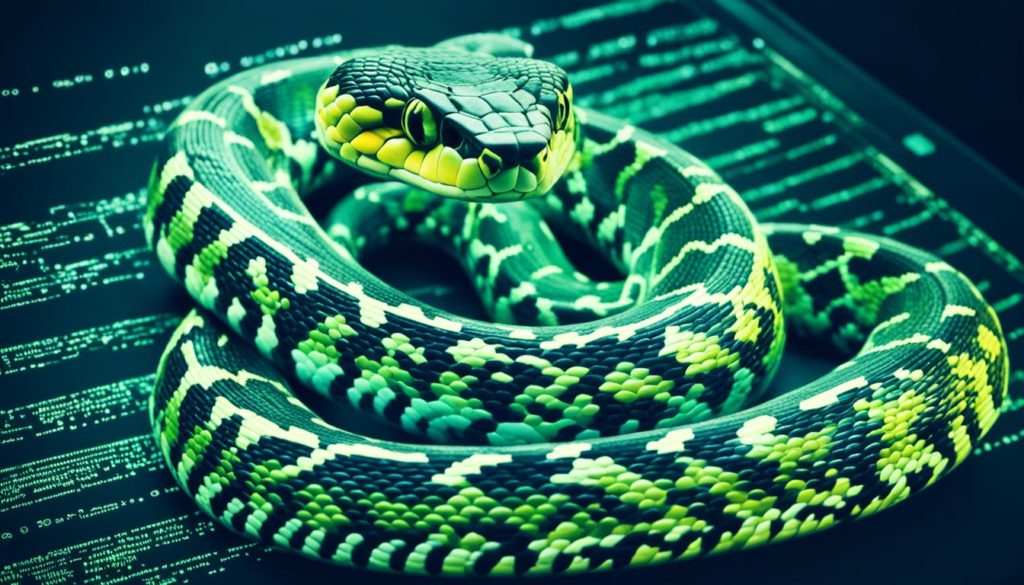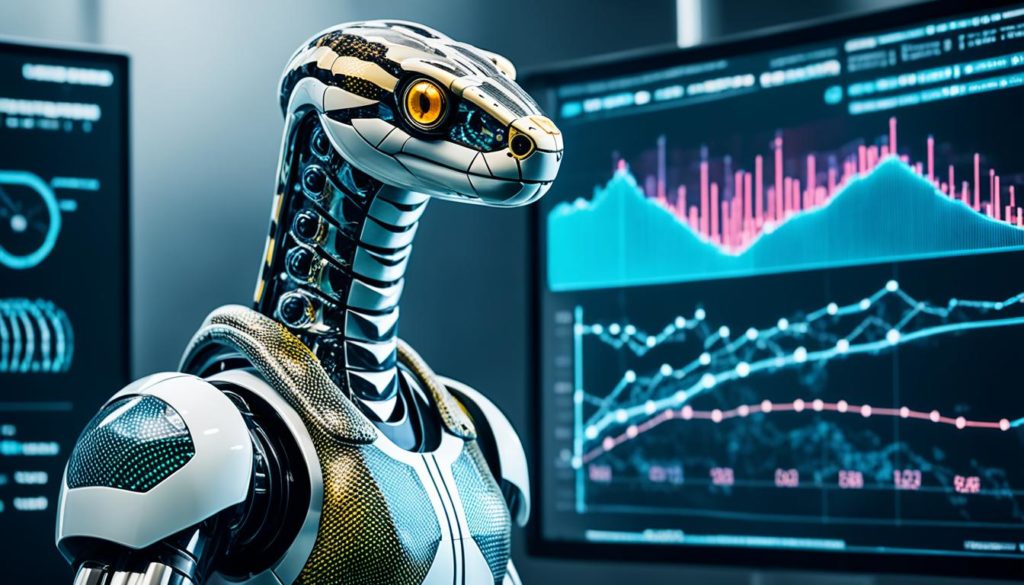
Do you know Python is a favorite for over 80% of developers? This shows how easy and adaptable Python is. It’s now a key part of many tech areas. Today, we’ll see how Python is used in real life and its many tech applications.
Data scientists and IT pros love Python’s wide library system. It’s great for making websites with Django or Flask and for AI projects. With Python, you can do so much. For example, you can analyze data with Pandas, or help make big software like Google or Netflix.
But Python isn’t just for data and AI. It also helps make games like “Pirates of the Caribbean” and apps like Netflix and Spotify better. Python’s simple rules and cool libraries are perfect for tasks like web scraping or automation. This makes daily jobs easier and faster.
Key Takeaways
- Python is the main coding language for over 80% of developers, showing it’s widely loved.
- Its ease and flexibility make it perfect for different tech fields.
- Django, Flask, Pandas, and more add so much value to Python.
- It’s behind big web and software projects by Google, Netflix, and Reddit.
- Python also boosts AI, machine learning, automation, and game making.
Introduction to Python: A Versatile Programming Language
Python is a standout choice for beginners and experts with its clean and easily readable style. It’s especially powerful when used in web development. For example, libraries such as BeautifulSoup and Scrapy help with web scraping.
It’s not just for web work though. Python helps a lot in data science. For data analysis, experts use libraries like Pandas and NumPy. This shows Python’s strength and efficiency.
For scientific work and automation, Python is a key player. Its dynamic typing and interpreted nature make development fast.
In computer graphics and machine learning, Python is essential. It has powerful libraries like TensorFlow and PyTorch for making advanced models. For managing big data, tools like Apache Spark are used effectively.
Now, let’s dive into Python’s core features that make it a versatile programming language:
- Interpreted Language: Makes development and debugging easier.
- Dynamic Typing: Adds flexibility by allowing variable types to change at runtime.
- Extensive Libraries: Provides libraries for many areas, from web scraping to machine learning.
Python is also known for its strong community and being open source. This leads to a wide range of frameworks and libraries. Python is used in automation, AI, science, and more, showing its crucial role in programming.
Python Uses in Web Development
Python plays a big role in making websites these days. It’s all thanks to awesome tools like Django and Flask. These tools help developers create apps quickly and easily.
Frameworks: Django and Flask
Django is known for its powerful tools that come built-in. It makes creating big, secure apps simpler. On the other hand, Flask’s lightweight design is great for smaller projects. It gives developers more freedom to customize.
Benefits for Developers
Python makes building websites safer and faster. With its simple syntax and many libraries, creating apps is a breeze. Plus, the Python community is always ready to help with advice and resources.
Popular Web Applications Built with Python
Many famous sites use Python for their backend, such as Spotify and Netflix. Spotify uses Django to run its music service. Netflix uses Python to suggest shows and manage its huge content library. It shows Python can handle big websites smoothly.
| Web Application | Framework Used |
|---|---|
| Spotify | Django |
| Netflix | Flask |
Data Analysis and Visualization with Python
Python is key in data analysis and visualization today. It’s a vital tool for data scientists because of its strong libraries and easy learning curve. We’ll explore the top libraries, how they’re used in the real world, and the perks they offer.
Libraries: Pandas, NumPy, and Matplotlib
Pandas, NumPy, and Matplotlib are essential for analyzing and showing data with Python. Pandas lets users manage data easily through structures like DataFrames. NumPy assists in complex calculations with arrays and matrices. And Matplotlib is great for creating various visualizations to make data clear.
Real-world Applications
Python’s data skills are crucial in fields like finance and healthcare. In finance, it helps analyze big data to spot market trends. Healthcare uses Python to interpret patient and genomic info. This makes decision-making easier in both fields by turning complex data into simple visuals.
Benefits for Data Scientists
Data scientists find the Python ecosystem incredibly useful. Its tools help clean, analyze, and visualize data, streamlining the process. This leads to finding patterns and insights for smarter decisions. Python’s flexibility and libraries are what make it a go-to for data scientists.
| Library | Key Functions | Example Use Case |
|---|---|---|
| Pandas | Data Manipulation | Cleaning and transforming survey data |
| NumPy | Numerical Operations | Performing large-scale matrix operations |
| Matplotlib | Data Visualization | Creating sales trend graphs |
Data scientists armed with Python for data analysis and visualization are ready for the challenges of today. Their work helps various fields make informed decisions, leading to impactful solutions.
Machine Learning and Artificial Intelligence with Python
Python is now the top pick for developers in machine learning and artificial intelligence. Its strong libraries and user-friendly nature make it perfect. We’ll explore the key tools and techniques making Python so vital in these areas in this part.
Key Libraries: TensorFlow, PyTorch, and Scikit-learn
At the top of the list are TensorFlow and PyTorch. They let us create complex neural networks easily. TensorFlow is great for a wide range of tasks, and developers love PyTorch for its easy-to-understand approach.
Scikit-learn is also crucial. It has a full set of algorithms for many tasks like regression and classification. Its straightforward design is a big plus for Python’s machine learning kit.
Building and Deploying Models
With Python, making and putting out models is straightforward thanks to powerful libraries. These let us create models for things like telling what’s in a picture to understanding human language. And Python’s flexible tools help spread these models to different places.
Python’s AI powers are key in bettering how we drive self-driving cars or predict business trends. Tools like TensorFlow, PyTorch, and Scikit-learn make crafting and sharing models simpler and more effective than ever.
Python Uses in Everyday Scripting and Automation
Python has changed how we handle daily jobs, becoming key for many. It’s used by developers and companies for easier workflows. Let’s look at how Python helps in automating tasks and simplifying everyday work through its libraries.
Common Scenarios: Web Scraping, Task Automation
Python makes it easy to automate tasks we do over and over, like web scraping with Python. Tools like BeautifulSoup and Selenium let us pull information from web pages. This is often used in market research and to study rivals. Python’s task automation can also handle system checks, manage files, and send updates. This cuts down on the time spent doing these tasks by hand.
Popular Libraries: BeautifulSoup, Selenium, and Scrapy
Python shines in automating tasks thanks to some top libraries:
- BeautifulSoup: It’s great for web scraping, turning HTML and XML into data easily. This makes searching and changing web data simple.
- Selenium: It’s used for automatically testing websites. Selenium interacts with web browsers, crucial for tasks needing browser use.
- Scrapy: For bigger web scraping jobs, Scrapy is powerful. It can crawl many pages, pulling data together quickly and efficiently.
Advantages of Using Python for Automation
There are many pros to picking Python for automation:
- Efficiency: It’s fast, making tasks complete quickly without delays.
- Reduced Errors: Python automation means fewer mistakes, leading to more precise work.
- Community and Resources: Python’s community and library support make finding help and pre-made solutions easy.
In short, whether you’re scraping websites or automating big jobs, Python is a great choice. It boosts how quickly we work, making tech tasks much smoother and less stressful daily.
Conclusion
Summing up, Python’s reach in tech is deep. It’s found in software, the web, AI, and data science. Python stands out thanks to its many built-in tools and extra help from libraries and frameworks. This makes work faster for developers and IT pros in many fields.
Learning Python opens doors to tech innovations. It’s vital for web work and sharp data analysis. It also shines in machine learning and for making tasks automated. Python keeps making things better and more efficient everywhere.
Python looks to the future with its ongoing improvements. It will keep meeting the latest tech needs. Using Python tools, developers can dream big, leading to cool new tech. Let’s stay curious and see where Python takes us in tech.
FAQ
What are the primary applications of the Python programming language?
Python is mainly used in creating websites, analyzing data, and in technologies like AI and machine learning. It also works for making tasks easier and automation. Its many libraries help developers in different tech fields.
What makes Python a user-friendly language for new programmers?
Python stands out for how easy it is to read and use. Its simplicity speeds up the learning process for new coders. This has led many to choose it, making it very popular.
How does Python enhance web development?
For web development, Python uses frameworks like Django and Flask. These make it easier to work with databases, create templates, and ensure secure logins. This helps developers work more efficiently and safely.
Which web applications use Python for their back-end operations?
Big web apps like Spotify and Netflix rely on Python for their back-end work. This shows how trusted and important Python is in the tech industry.
What are the key libraries used in Python for data analysis and visualization?
Python uses Pandas for shaping data, NumPy for dealing with numbers, and Matplotlib for making charts. These are the essential tools for understanding and showing data.
What roles do TensorFlow and PyTorch play in Python machine learning?
TensorFlow and PyTorch are crucial for making AI systems in Python. They make it possible to build and run deep neural networks. This leads to exciting advances in AI.
How does Python facilitate task automation?
With Python, you can make your computer handle repetitive jobs using libraries like BeautifulSoup. This includes tasks like scraping websites. It’s a way to avoid mistakes and save time.
What are some common real-world applications of Python in data science?
In the real world, Python is used for working with, analyzing, and showing data. It’s used in everything from finance to healthcare, making complex data simple to understand.
Future App Studios is an award-winning software development & outsourcing company. Our team of experts is ready to craft the solution your company needs.










